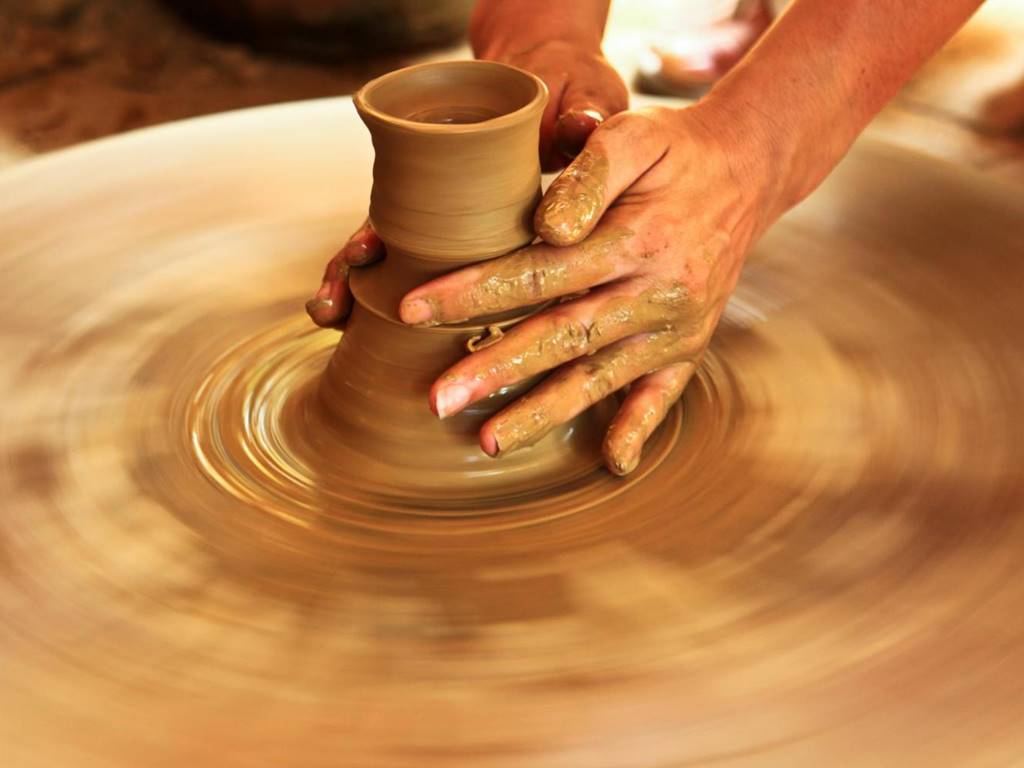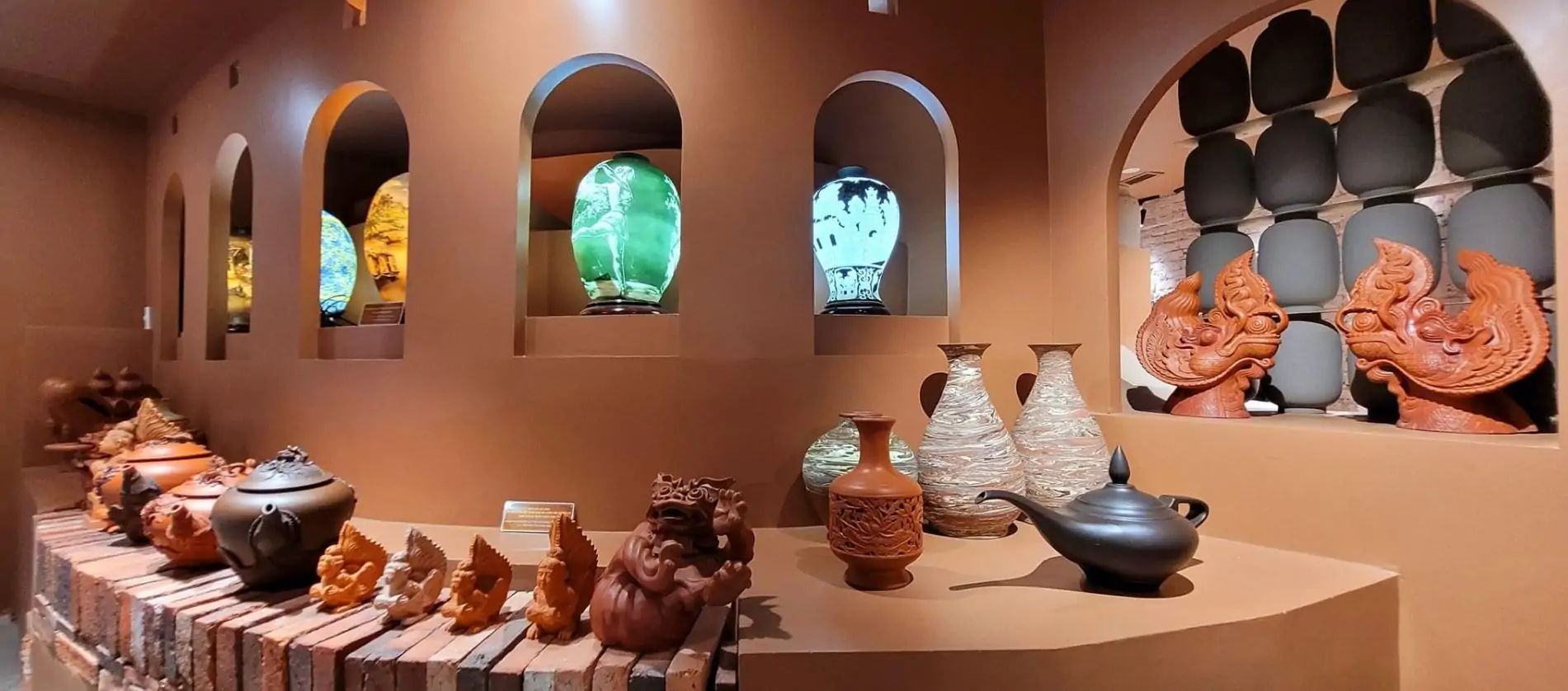News
Enhance Tourism Related to Bat Trang Ceramics
Bat Trang ceramics have long been celebrated as a symbol of Vietnamese cultural heritage. This unique craft, originating from the Bat Trang village near Hanoi, is renowned for its exquisite pottery and ceramics that combine traditional techniques with modern aesthetics. The distinctiveness of Bat Trang ceramics not only lies in their artistic value but also in the historical narrative they carry. Enhancing tourism related to Bat Trang ceramics presents an excellent opportunity to promote cultural exchange, bolster the local economy, and preserve traditional craftsmanship for future generations.
Understanding Bat Trang Ceramics: History and Cultural Significance

To truly enhance tourism around Bat Trang ceramics, it is essential first to understand the historical roots and cultural significance of this craft. This section explores how Bat Trang ceramics came into being, their evolution over centuries, and why they hold such a revered place in Vietnamese culture.
Before diving into specific aspects, recognizing the deep connection between Bat Trang ceramics and Vietnamese identity helps tourists appreciate the experience beyond mere souvenirs or decorative items.
Historical Origins of Bat Trang Ceramics
Bat Trang’s ceramic tradition dates back more than 700 years to the Ly-Tran dynasties, positioning it as one of the oldest pottery villages in Vietnam.
The village’s location along the Red River provided abundant natural resources—clay, sand, and water—that were perfect for pottery-making.
Over centuries, artisans honed their skills, passing techniques down through generations, which allowed Bat Trang ceramics to develop distinctive styles recognizable worldwide.
The survival of this craft despite industrialization reflects the resilience and adaptability of Bat Trang’s community.
This context gives tourists insight into the authenticity and heritage behind each ceramic piece.
Cultural Importance in Vietnamese Society
Bat Trang ceramics are not just functional items; they are woven into the fabric of Vietnamese rituals, daily life, and artistry.
Ceramic products range from everyday household utensils to ceremonial items used in weddings, ancestral worship, and festivals.
In many Vietnamese homes, Bat Trang ceramics symbolize prosperity and respect for tradition.
By understanding these cultural layers, visitors can better appreciate the symbolic meaning embedded within the designs and forms.
Moreover, the patterns and motifs often tell stories from Vietnamese folklore and history, providing a rich narrative for cultural tourism.
Evolution of Techniques and Designs
While rooted in ancient methods, Bat Trang ceramics have continually evolved to meet changing tastes and market demands.
Originally focused on utilitarian wares like bowls and jars, artisans gradually incorporated artistic elements such as intricate glazing, painting, and innovative kiln technologies.
Modern Bat Trang ceramics now blend traditional blue-and-white porcelain stylings with contemporary designs appealing to both domestic and international buyers.
This evolution showcases the dynamic nature of craft traditions and encourages tourists to explore a wide variety of products—from classic replicas to avant-garde art pieces.
It also positions Bat Trang ceramics as a bridge between past and present, making the village a compelling destination for experiential learning.
Personal Insights on Historical and Cultural Appreciation
Bat Trang ceramics embody more than just material craftsmanship; they reflect a way of life and cultural continuity.
When tourists immerse themselves in the story behind each ceramic product, they gain a deeper emotional connection to Vietnam’s heritage.
Travelers today increasingly seek meaningful experiences rather than passive sightseeing, making cultural immersion a key driver for tourism growth.
Therefore, framing Bat Trang ceramics as living history and heritage art enhances their appeal.
Investing in storytelling, workshops, and artisan interactions transforms visits into memorable encounters with tradition.
Local communities benefit by reaffirming their identity and gaining sustainable income sources, creating a virtuous cycle of preservation and promotion.
Developing Experiential Tourism in Bat Trang Village

Enhancing tourism related to Bat Trang ceramics requires innovative approaches that engage visitors actively. Moving beyond passive observation to hands-on experiences can create lasting impressions and encourage word-of-mouth promotion.
This section will explore how experiential tourism strategies can be implemented effectively in Bat Trang to attract diverse tourist segments.
Craft Workshops and Interactive Learning
One of the most powerful ways to deepen visitor engagement is through participatory craft workshops.
Tourists can learn traditional pottery techniques such as clay preparation, shaping on the wheel, glazing, and firing processes.
These immersive sessions allow visitors to appreciate the skill involved and connect emotionally with the craft.
Workshops should be designed for various skill levels, including beginners, families, and enthusiasts, ensuring inclusivity.
Additionally, highlighting environmental sustainability practices in ceramics production can add educational value aligned with growing eco-tourism trends.
Creating souvenir opportunities where tourists take home their handmade ceramics further solidifies positive memories.
Guided Tours with Storytelling Elements
Structured guided tours of Bat Trang village can greatly enhance the visitor experience by adding contextual depth.
Professional guides knowledgeable about the history, techniques, and social impact of Bat Trang ceramics serve as storytellers bridging past and present.
Tours could include visits to family-run kilns, artisan studios, and the Bat Trang Ceramic Museum, supplemented by demonstrations.
Interactive QA sessions and cultural performances related to ceramics (such as folk music or dance) make the experience more vivid.
Using multilingual guides or app-based audio tours increases accessibility to international tourists.
A well-crafted narrative creates emotional resonance, encouraging tourists to share their experiences and return for repeat visits.
Integration of Culinary and Cultural Events
Integrating Bat Trang ceramics with Vietnamese culinary and cultural events enriches the tourism offering.
For example, organizing tea ceremonies or cooking classes using Bat Trang ceramic ware highlights the synergy of craft and gastronomy.
Seasonal festivals celebrating ceramic art combined with traditional music, dance, and street markets provide vibrant atmospheres attracting both locals and tourists.
Collaborations with nearby attractions such as Duong Lam ancient village or Red River boat tours create comprehensive day-trip packages.
Such multi-dimensional experiences satisfy diverse interests and extend tourist stays.
Highlighting Bat Trang ceramics’ role in daily life through food culture adds relatable context and emotional appeal.
Digital Engagement and Virtual Experiences
In today’s digital age, enhancing tourism also involves leveraging technology to reach broader audiences.
Virtual reality (VR) and augmented reality (AR) applications can simulate pottery-making processes or virtual tours of Bat Trang village for those unable to travel physically.
Online platforms featuring artisan interviews, live-streamed workshops, and interactive e-commerce sections boost global visibility.
Social media campaigns showcasing user-generated content help build community and buzz.
Digital storytelling complements onsite experiences and attracts younger travelers who prioritize technology integration.
Balancing traditional authenticity with modern digital tools ensures sustained interest in Bat Trang ceramics tourism.
Personal Reflections on Experiential Tourism Impact
Experiential tourism transforms visitors from passive observers into active participants, fostering a deeper appreciation and stronger emotional connections.
When tourists engage directly with Bat Trang ceramics through hands-on activities, narratives, and sensory experiences, cultural values become tangible.
This approach not only enriches visitor satisfaction but also supports artisans by providing additional revenue streams and recognition.
However, care must be taken to ensure authenticity is preserved and commercialization does not dilute cultural integrity.
Sustainability principles should guide all tourism development to safeguard Bat Trang’s heritage for future generations.
Ultimately, experiential tourism empowers both hosts and guests, creating mutually beneficial cultural exchanges that transcend conventional tourism boundaries.
Marketing Strategies to Promote Bat Trang Ceramics Tourism

Successful enhancement of tourism linked to Bat Trang ceramics depends heavily on effective marketing strategies tailored to target audiences domestically and internationally.
This section discusses potential marketing channels, branding ideas, partnership opportunities, and promotional tactics to elevate Bat Trang ceramics on the global tourism map.
Branding Bat Trang Ceramics as a Cultural Icon
A strong brand identity encapsulating the uniqueness, craftsmanship, and heritage of Bat Trang ceramics is essential for market differentiation.
Developing a cohesive visual logo, tagline, and narrative that evoke tradition and quality helps build recognition across platforms.
Positioning Bat Trang ceramics as authentic Vietnamese artisan products aligns with growing consumer demand for meaningful souvenirs.
Brand messaging should highlight the handcrafted nature, historical lineage, and story-rich designs to connect emotionally.
Collaborations with cultural institutions, designers, and influencers amplify brand credibility and appeal.
Effective branding turns Bat Trang ceramics from simple goods into coveted cultural icons driving tourism interest.
Utilizing Digital Marketing and Social Media
Leveraging digital marketing tools such as SEO, content marketing, email campaigns, and paid advertising targets potential tourists efficiently.
Maintaining active social media profiles on Instagram, Facebook, TikTok, and Pinterest allows showcasing stunning ceramics visuals, behind-the-scenes videos, and user testimonials.
Engaging storytelling posts and contests generate interaction and sharing.
Influencer partnerships with travel bloggers, artists, and cultural ambassadors provide authentic endorsements and expand reach.
Regular updates featuring new collections, events, and workshop schedules keep audiences informed and eager to visit.
Data analytics can track campaign effectiveness and inform continuous improvements.
Collaborations with Travel Agencies and Tour Operators
Partnering with travel agencies and tour operators specializing in cultural and craft tourism broadens Bat Trang ceramics’ access to inbound tourist markets.
Offering packaged tours that include visits to the village, workshops, museum entries, and shopping incentives creates comprehensive experiences for travelers.
Negotiating group discounts or exclusive deals encourages booking through official channels.
Training frontline service providers on Bat Trang ceramics’ background equips them to upsell and enhance customer satisfaction.
Tour operator collaborations also facilitate participation in international trade shows and tourism fairs, raising profile among industry stakeholders.
This multi-pronged approach ensures steady inflows of tourists attracted by trusted travel brands.
Hosting International Exhibitions and Festivals
Organizing international exhibitions and festivals dedicated to Bat Trang ceramics boosts visibility and prestige.
Inviting foreign collectors, ceramic experts, and media generates cross-cultural dialogue and expands export opportunities.
Such events can showcase rare antique pieces alongside contemporary artworks, reflecting the craft’s full spectrum.
Cultural exchange programs involving artists-in-residence and collaborative projects position Bat Trang as an innovation hub.
Festivals incorporating live demonstrations, competitions, and educational talks attract diverse audiences.
These activities foster pride among local residents while strengthening Bat Trang’s reputation as a world-class ceramic center.
Personal Perspectives on Effective Marketing Approaches
Marketing Bat Trang ceramics tourism demands a balance of tradition and modernity, authenticity and innovation.
Every marketing message should convey the soul of Bat Trang’s craft, avoiding superficial commercialism.
Engaging digital narratives combined with real-life experiences cultivate emotional connections essential for loyal customers.
Strategic partnerships magnify efforts, pooling resources and expertise to reach wider audiences.
By prioritizing cultural respect and visitor education, marketing becomes a tool for sustainable cultural tourism growth.
Ultimately, successful promotions translate into increased visitor numbers, improved artisan livelihoods, and reinforced cultural preservation.
Infrastructure Development and Sustainable Tourism Practices

For the long-term success of tourism connected to Bat Trang ceramics, investment in infrastructure and adherence to sustainable practices are vital.
This section examines current challenges and opportunities related to transportation, accommodations, facilities, and environmental management within Bat Trang village and surrounding areas.
Improving Accessibility and Transportation Options
Though located near Hanoi, accessibility to Bat Trang village can still be improved to accommodate increasing tourist flows comfortably.
Upgrading road signage, parking facilities, and public transport services facilitates convenient travel.
Introducing shuttle buses or eco-friendly transport options reduces traffic congestion and pollution.
Integrating Bat Trang stops into Hanoi city tours or regional travel circuits enhances convenience for foreign visitors.
Improved connectivity encourages spontaneous visits and longer stays, benefiting local businesses.
Attention to accessibility also includes facilities for differently-abled tourists, expanding inclusivity.
Enhancing Accommodation and Hospitality Services
Currently, Bat Trang has limited accommodation options, mostly small guesthouses or homestays.
Expanding quality lodging choices that reflect local architecture and hospitality standards caters to diverse visitor preferences.
Boutique hotels, eco-lodges, or creative co-living spaces appeal to cultural travelers seeking immersive stays.
Training hospitality staff in language skills, cultural sensitivity, and customer service improves overall visitor satisfaction.
Developing culinary offerings featuring local cuisine in cafes and restaurants complements the tourism ecosystem.
Accommodations integrated with ceramic-themed decor or workshops offer unique selling points.
Implementing Environmental and Cultural Preservation Measures
Sustainable tourism practices ensure that environmental impacts remain minimal and cultural heritage is protected.
Proper waste management systems prevent pollution in the village and surrounding river ecosystems.
Encouraging use of renewable energy sources within ceramic kilns and tourist facilities reduces carbon footprints.
Conservation of traditional kiln structures and artisan workshops maintains authenticity.
Community involvement in tourism planning guarantees equitable benefits and safeguards intangible cultural assets.
Educational campaigns for visitors promote responsible behavior and respect for local customs.
Sustainability safeguards Bat Trang’s charm and viability as a tourism destination for generations ahead.
Leveraging Community Participation and Capacity Building
Empowering the local community through capacity building strengthens tourism development.
Providing training programs on hospitality, business management, foreign languages, and digital literacy enhances artisan competitiveness.
Supporting women and youth entrepreneurship encourages innovation and diversification.
Community-led tourism initiatives enable locals to design products and experiences reflecting their values.
Open communication channels among stakeholders foster collaboration and conflict resolution.
Active community ownership ensures that tourism growth aligns with local needs and aspirations.
Personal Analysis on Infrastructure and Sustainability Balance
Infrastructure development must be thoughtful and culturally sensitive to avoid commodifying or disrupting Bat Trang’s traditional lifestyle.
Improvements should prioritize quality over quantity, focusing on facilities that enhance visitor comfort without sacrificing authenticity.
Sustainability is not merely an option but a necessity in today’s global tourism environment, where conscious travelers seek eco-friendly destinations.
Community empowerment transforms tourism into a platform for cultural pride and socio-economic upliftment rather than exploitation.
Careful planning, transparent governance, and continuous monitoring are crucial to maintaining this delicate balance.
Bat Trang ceramics tourism thus becomes a model of integrating heritage conservation with modern development.
Conclusion
Enhancing tourism related to Bat Trang ceramics offers a multifaceted opportunity to celebrate Vietnam’s rich cultural heritage while driving sustainable economic growth. By deeply understanding the historical and cultural significance of Bat Trang ceramics, visitors gain meaningful connections that transcend typical souvenir hunting. Developing experiential tourism through workshops, guided storytelling, and integrated cultural events creates immersive and memorable experiences that attract diverse audiences. Strategic marketing combining strong branding, digital outreach, and partnership networks elevates Bat Trang ceramics on the global stage. Meanwhile, investing in infrastructure improvements, environmentally conscious practices, and active community participation ensures that tourism development honors and preserves the village’s unique character and traditions. Together, these efforts form a holistic approach that not only enhances visitor satisfaction but also empowers local artisans and safeguards Bat Trang ceramics as a vibrant cultural treasure for future generations.
